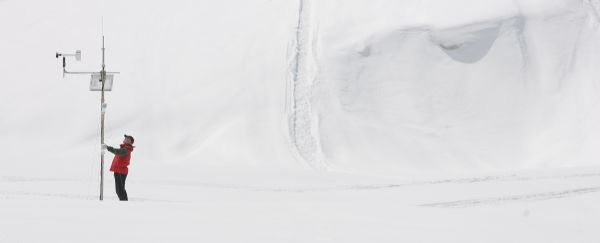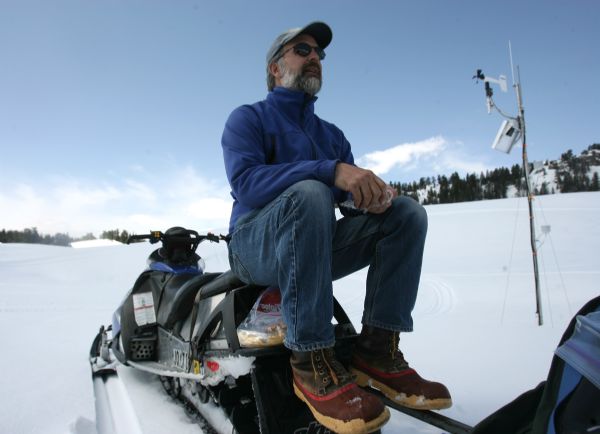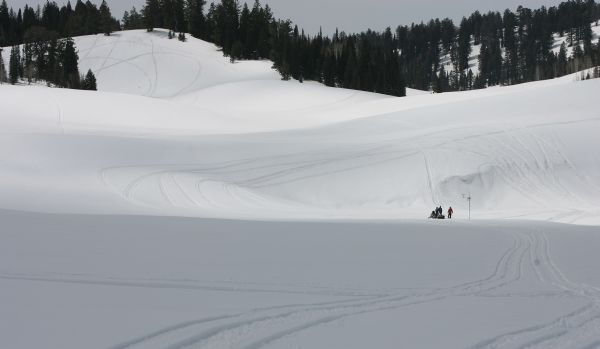This is an archived article that was published on sltrib.com in 2010, and information in the article may be outdated. It is provided only for personal research purposes and may not be reprinted.
Peter Sinks » In the world of extreme weather, Peter Sinks is Utah's most reliable crowd pleaser.
Less than two weeks ago, it registered as the coldest spot in the contiguous United States when the temperature fell to minus 27 Fahrenheit. The next most frigid location in the lower 48 that day -- April 14 -- was West Yellowstone, Mont., at a cozy 4 below.
Located at the bottom of a basin in the Bear River Range of the Wasatch Mountains at an altitude of 8,164 feet, Peter Sinks racked up an impressive record once again this season.
Since October, a solar-powered monitoring station at the site has logged the lowest temperature in the nation on 20 days -- even colder than anywhere in Alaska. For 66 days, it also recorded the most frigid readings in the lower 48.
Plus, the lowest temperature in the lower 48 states all winter was recorded there Feb. 22.
None of this is likely to surprise people who watch extreme weather. They know the Sinks made history back on Feb. 1, 1985, by registering the lowest temperature ever recorded in Utah and the second-coldest ever recorded in the continental United States -- a lung-stinging minus 69.3 degrees Fahrenheit.
Since then, researchers have monitored the area sporadically, even as wintertime snowmobilers and summertime hikers have made the beautiful Peter Sinks area and nearby Middle Sink in the Wasatch-Cache National Forest a recreation hotspot.
Middle Sink can be seen off the east side of Highway 89 about 20 miles northeast of Logan. A depression in a vast basin near the mountaintops, it holds low temperature records for March (minus 52), April (minus 41), November (minus 47) and December (minus 54) in Utah.
Getting to Peter Sinks means climbing a couple of ridges deeper in the Bear River Mountains. Even with a five-foot-covering of snow, you can see a dimple at the bottom of the vast, snowy bowl that is the north lobe of the sinks. Another sinkhole is pressed into the limestone about a football field away, behind a snow-covered rise.
Taking a 360-degree view from the bottom, the only signs that people come here are the snowmobile tracks looping to the ridge rims and, just outside the north sinkhole depression, a slender pole poking about 12 feet into the air that holds thermometers and a high-tech whirly-gig monitoring wind speed and direction. It's topped by a small solar-panel. An instrument box is buried under snow at the bottom.
This basin topography is key to the wacky temperatures at Peter Sinks, says Jonathan Carlisle, who set up and maintains the monitoring station for the climate center, which is based at Utah State University in Logan.
"At night, when there is very little wind, you get cold air that is very dense that settles and flows down the side walls of these large sink holes and collects," he explains, describing the phenomenon known as air pooling.
The air pours down to the sinkhole, where there is no outlet for the frigid air and no wind -- especially in the calm after a storm -- to stir the air with warmer currents. "So, there is no flow, no way for the cold air to move out," Carlisle said. "The cold air accumulates."
The area's only trees fringe the basin's upper edges. In summer, grasses and sage grow but little else, thanks to freezing temperatures every few days.
"If you were a plant trying to survive down here above the snowpack," he says, "it would be a brutal place, with the extremes and fluctuations."
So brutal, that it is named after the miner whose life it claimed, legend has it.
According to Last Unspoiled Place: Utah's Logan Canyon by Michael S. Sweeney, the miner tried to homestead the place.
"When he didn't show up after a nasty winter," goes the third-hand account, "a search party from Bear Lake went looking for him. The party found him frozen to death."
As usual, Peter Sinks produced more jaw-droppers this winter.
It had the winter's lowest temperature in the contiguous United States, a breath-taking minus 46 Fahrenheit in the early morning of Feb. 22. Coming in a distant second that day was the 25 below zero registered at Shirley Basin, Wyo., and nearby Logan, Utah, had a relatively balmy low of 3.2.
Peter Sinks then experienced warp-speed warming, as the record low temperature of the morning of Feb. 22 increased about 79 degrees in only 4.5 hours.
The Utah Climate Center hopes to persuade its partners to continue their observations through the summer.
State Climatologist Rob Gillies said many northern Utah spots exhibit similar patterns. He calls them "microclimates."
"We learn there are myriad microclimates all throughout the terrain," he said. "And, if it wasn't for the curiosity of individuals coming up and finding there are such temperature extremes, you would only be guessing at them and not measuring them."
Extreme-weather guru Trent McCotter has been prodding the Climate Center to update and automate the monitoring equipment (provided by Logan-based Campbell Scientific) so that he can keep up with developments while attending law school in North Carolina.
He calls himself one of the Sinks' biggest fans and suspects others will be joining him as the area grows a following.
"Once people learn about the Sinks, I think they'll become a popular 'cold spot' to check --- just like International Falls, Minn. ," he wrote in an e mail. "I think part of the popularity of these places is that it reminds us that, no matter how cold it is where we are, it's probably colder somewhere else!"
McCotter notes that he has never visited the Sinks, or even Utah, for that matter. He first read about them in Chris Burt's Extreme Weather Guide , then became an avid tracker of data that has streamed hourly all winter from the site.
To him, Peter Sinks is definitely worth watching closely.
"There are lots of places where the temps are colder because of a depression in the land -- you can feel the same thing in your backyard on a summer night if you have a dip in the land," he wrote. "But the Sinks are just unparalleled in their ability to get cold at any time of the year."
Utah's extreme weather star had a workout this winter
Peter Sinks holds state records for seven months of the year in Utah. The February low is also the second-lowest temperature ever recorded in the lower 48 states.
| January » | minus 66 F | 1985 |
| February » | minus 69.3 | 1985 |
| May » | minus 19 | 1983 |
| June » | 3 | 2001 |
| August » | 7 | 2005 |
| September » | minus 10 | 2000 |
| October » | minus 35 | 2002 |
Source: Utah Climate Center







